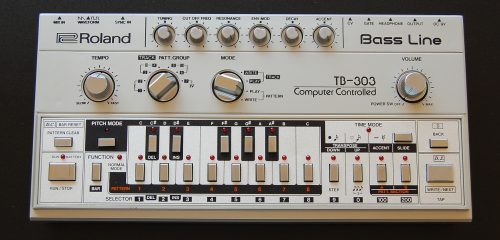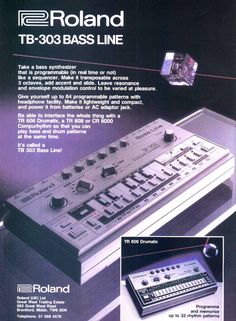
The Roland TB-303 is one of the most influential electronic instruments to date. The story of the instrument and its influence remind us that objects can be “active agents rather than passive instruments or backdrops for human activity” (Boyle, Barnett).

The machine is an analogue, monophonic bass line synthesizer created in 1982 by Roland. Designed as a companion piece for performing or practicing musicians, it was a band mate and instructor in one. The machine could not be played as a bass guitar would be, or really as any standard synthesizer or instrument would have been in its time: it was completely sequence based, meaning you could not utilize or “play” the instrument without preemptive arranging or organizing. Since you could not enable playback during note input, you had to manually input each note on each particular step 1-16 without being able to stop mid-sequence and hear what you’ve added. This gave the machine a reputation of being unusable, as it mysteriously translated the users input into its own odd sequence.
The machine did not sound like a bass guitar. It was heralded as one of the worst sounding synthesizers ever produced. Further, the machine was over-equipped with parameter adjustments, having 6 different parameter knobs that tweaked the sound. Inevitably, the 303 was a commercial failure, in less than two years production was halted, and the 303 was relegated to pawn shops, no one wanted it or cared that it existed.
All this changed when Pierre Jones (DJ Pierre) found a barely used 303 in a Detroit pawn shop, and bought it for 40 dollars. The amateur DJ/Producer and his friend, known now as Jasper G, took the device home and synced it up with the gear they already had. Neither of them knew how to program the synth, so they let the synth play its own patterns (from the factory or the previous owner). Noticing the parameter knobs, Pierre started tweaking the knobs, trying in whatever way available to customize and augment the sound coming from the box. While twisting and turning the dials, Jasper (who was jamming along to the 303 with a drum machine) started hearing alien squelching sounds that were unlike anything he had heard before, and encouraged Pierre to continue experimenting with the parameters. As the story goes, the two spent 3-4 hours jamming that one session, and the result was the first track of its kind, later to be dubbed “acid house”, not in relation to the drug but the inherently oddball noises the 303 made when the resonance and envelope modulation parameters were pushed to their limits. The song was dubbed “Acid Tracks”, and the rest is history.
https://youtu.be/JCUPc9zVfyo
This track would eventually become a successful record, a canonical club anthem that helped spawn the genre of “acid”, which is still popular in underground electronic music circles, and has had a number of isolated mainstream appearances. The 303 itself is now one of the most sought after and expensive analogue synthesizers around, and has spawned a number of clones, (compared in the below video) that fail to capture the unique character of the original, though some get close.
 The story demonstrates how an object can defy the intentions of its “creator” and the purpose it was designed for, and in doing so, become a transformative object that enables new forms of creativity. The machine surpassed its designated purpose, and possessed its own quirky and alien features which were unintended. The divide between the design intentions, and the uses and sounds that the machine ultimately came to be known for, give the 303 an autonomy few other objects have. Seen from this perspective, it should come as no surprise that DJ Pierre described what happened that day as “discovery” rather than “invention”.
The story demonstrates how an object can defy the intentions of its “creator” and the purpose it was designed for, and in doing so, become a transformative object that enables new forms of creativity. The machine surpassed its designated purpose, and possessed its own quirky and alien features which were unintended. The divide between the design intentions, and the uses and sounds that the machine ultimately came to be known for, give the 303 an autonomy few other objects have. Seen from this perspective, it should come as no surprise that DJ Pierre described what happened that day as “discovery” rather than “invention”.

In the case of the 303, we had to wait some time, but eventually the machine spoke to us in its own language, disclosed its own sense of being, and quite literally, moved bodies (on the dance floor). The machine is thus a rhetorical “actor” insofar as its unique sonic character and strange mode of programming were persuasive and affective on those who heard it or used it to produce music. If “humans create technologies that then turn around to reshape them”, meaning “just as rhetoric is material, so, too, is materiality rhetorical” (Fleckenstein), then it must be seen how the myth of the TB-303 serves as example of the potential rhetorical agency of objects.
If you want to play around with a digital, flashed-based variant of the 303 (and a minimal, accompanying drum machine), here is the “Acid Machine Beta”(the program allows you build multiple patterns and chain them together, and to record your jam into a WAV file).
Want to learn more about ‘synthetic rhetoric’? Tune in for a video companion piece, coming soon!

